Eventing or Horse eventing is the supreme test of horsemanship and the horse. It combines the control of dressage, the endurance of cross country, and the suppleness of showjumping. Cross-country tests were initially designed for the cavalry. A military mount had to be able to cover long distances over rough country, keeping up a fair pace, and still be fit enough to work the next day.
Its rider had to be fit, too, a good judge of the country, and able to push his mount without over-exerting it and pick out the quickest and safest route, which often meant tackling fairly formidable obstacles. The military of mainland European countries held these very long-distance tests from time to time.
History of Horse Eventing
Equestrian events were introduced into the Olympic Games in Stockholm in 1912 and consisted of ‘prize riding,’ showjumping, and a pentathlon on horseback. The latter was open to serving officers riding military horses, and the minimum weight was 80kg. The pentathlon consisted of a long-distance ride of 55 km, which included cross-country on the first day, a steeplechase on the second, jumping on the third, and dressage on the fourth. Out of 24 starters, only 15 finished the test.
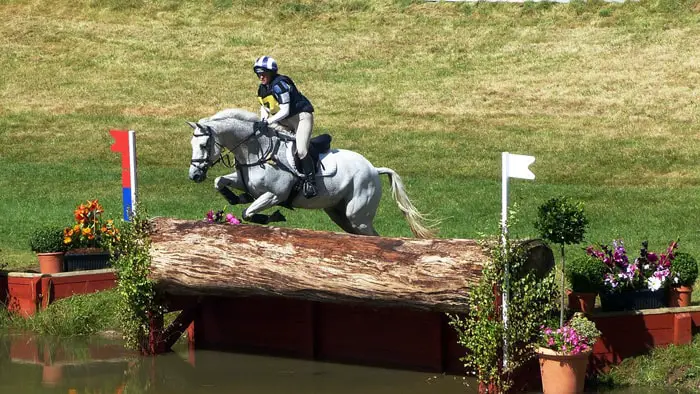
The form of the competition gradually evolved, and in 1924, it assumed much the same form as we know it today- dressage on the first day, speed and endurance on the second, and jumping on the third. Although civilians were now allowed in teams, none competed.
The continental European tradition of classical riding stood them in good stead, and Sweden and Holland dominated the first few equestrian Olympics. When the games were held in Los Angles in 1932, the home country took the team gold, but in those days, traveling time and expense were great, and there were few entries.
In 1948, the Equestrian Games were staged in England and helped raise the public’s enthusiasm for horse and riding. With the support of the British Horse Society, the first Badminton Three-Day Event took place in 1949, open to both services and civilians, including women. Watching the event was the Duke of Beaufort, who conceived the idea of building an eventing course on his estate at Badminton.
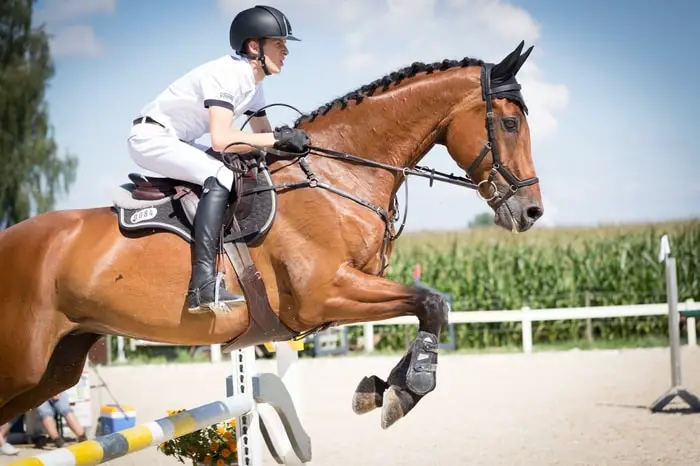
The idea was to find competitors for the next Olympic Games in Helsinki in 1952, but what was meant as a short-term project turned into a long-term success. The Badminton Horse Trails are the most prestigious and well-known in the horse world and among the general public.
Types of Eventing
Horse eventing is mainly two types; one-day eventing (ODE) and three-day eventing (TDE).
The One-Day Event (ODE)
The idea of a one-day event as a sort of taster for the Badminton Horse Trials was around for some time before it finally took off in 1950 in Oxfordshire over the Woodland Hunter Trial course. It was the forerunner of many one-day events, valuable training for the three-day, cheaper, and easier to organize and attend.
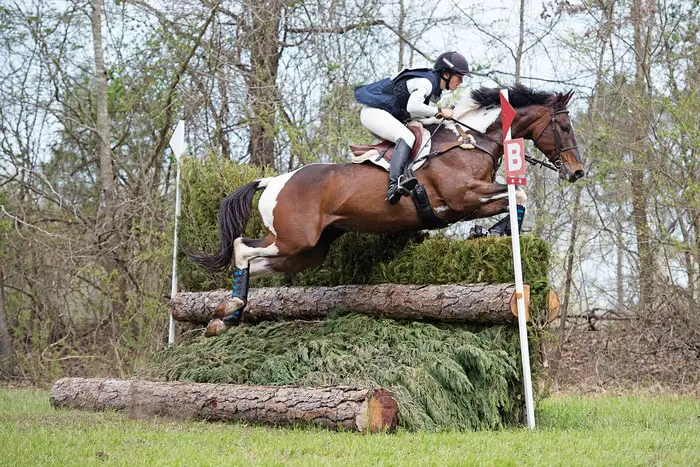
The Three-Day Event
Horses competing in Three-Day Events must be at least five years old and their riders at least 18. The marks are expressed in penalties and weighted so that values are 3 for dressage, 12 for Endurance, and 1 for jumping. The competitor with the lowest total of penalties is the winner.
As the event is held in the countryside, all courses except the dressage arena are different. Teams can be entered; all team members are automatically considered individuals though they may compete only once. An individual may enter more than one horse. The minimum weight carried for endurance is 75 kg; dressage and jumping have no minimum.
A draw determines the starting order, and that order is kept throughout the competition, except for the final day’s showjumping, when the order may be in the reverse of marks to that point so that the likely winners jump last.
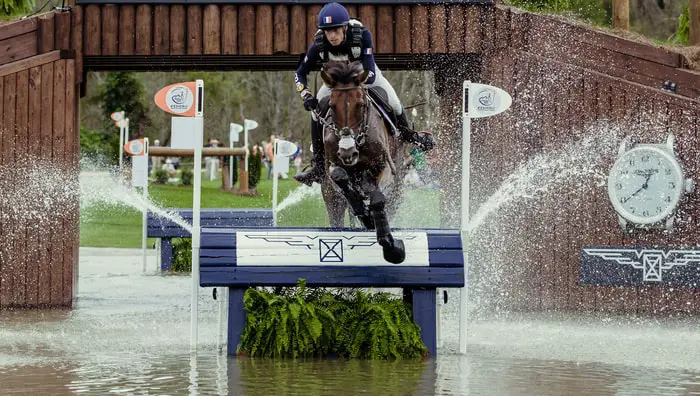
Day 1 is devoted to dressage. The rules, dress, and saddlery areas for any other dressage competition and the arena are average size and markings. The standard asked is not above medium, with the more complex movements left out, and generally conforms with the standard of the particular event. The horse shows good impulsion, suppleness, balance, the rider a good seat, and almost invisible application of aids. The aim is to produce an accurate performance of fluency and rhythm.
Day 2 is the speed and endurance test. The object is to prove the true cross-country horse’s speed, endurance, and jumping ability and the rider’s knowledge of pace and judgment of line of country. It is a test of the rider’s endurance as well, as it consists of four phases:
- Road and Tracks- to be ridden at a trot or slow canter. The time is around 10-12 km (6-7.5 miles), and riders may walk or run beside their horses, providing they are mounted at the finishing post.
- Steeplechase- the steeplechase course has between 20 and 32 relatively easy fences and is between 5-8 km (3-5 miles), ridden at a gallop. After this, the horse has a compulsory rest and a veterinary inspection before embarking on the crucial cross-country course.
- Road and Tracts.
- Cross-country.
Day 3 and so to the Final Showjumping
On Day 3, the competition is preceded by a veterinary inspection. The showjumping course is not severe, as the object of this exercise is to test whether the horse is still supple and obedient despite his previous day’s exertions. Various direction changes test his handiness. Penalties are given for excedding the time allowed and for the usual show jumping faults-disobedience, fall, foot in the water.
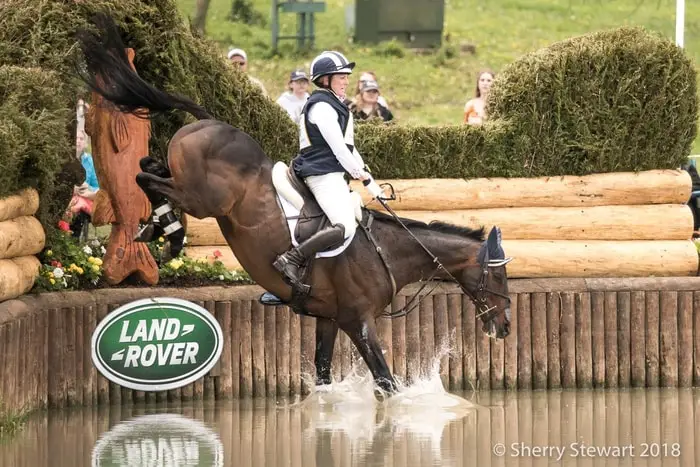
Horse Eventing: Horse and Rider
A very versatile type of horse is required for the exacting disciplines of eventing. He needs speed and stamina, intelligence, boldness, ability in jumping, and the temperament to remain calm in dressage but fiery over fences. Above all, he must be tough. He must, by international rules, be at least 15 hands for adult eventing. Horses this size have been successful, but they are the exceptions rather than the rule, and 16 hands is a better height for a prospective eventer.
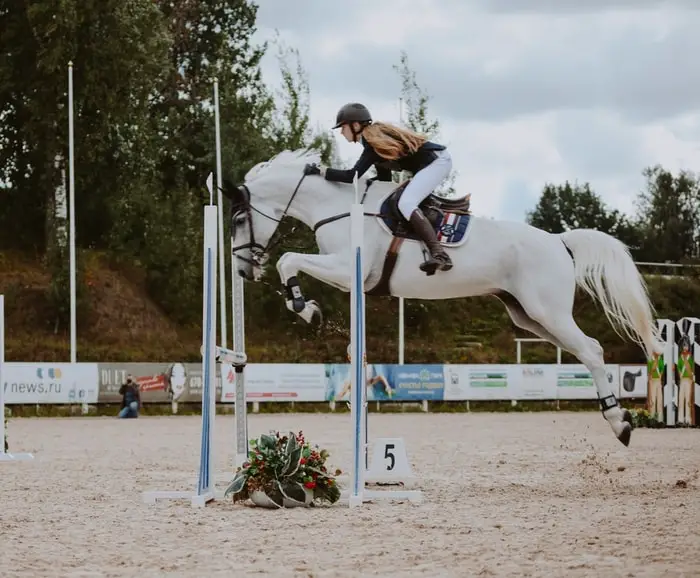
He needs to have hard bones, good conformation, and feet, be deep through the circumference and have strong hindquarters. When it comes to the crunch, a horse with heart and intelligence will get himself out of trouble where a lesser horse will land in it. Favored for training are Thoroughbreds and Quarterbreds, although several horses with different ancestry have made the sound.
Eventing Equipment
As well as talking horses and helpers to a three-day event, the eventer will need to take a load of clothing and equipment for the three disciplines, for example
- Dark jacket for showjumping and dressage.
- Two pairs of breeches.
- Tailcoat.
- Stock or tie.
- Shirt and pullover for cross-country.
- Three types of headgear.
- Boots and spurs.
- Whip.
- Dressage saddle and standard saddle.
- Numnahs.
- Bridles.
- Surcingle.
- Irons and leathers.
- Weight and weight cloth.
- Girths.
- Horse boots.
- Headcollar and rope.
- Lungeing equipment.
- Side reins.
- Grooming kit.
- Horse blanket.
- Feed and water bucket.
- Hay-net.
- Bandages.
- Towels.
- Set of spare shoes.
- Studs.
- Perhaps extras such as food and drink for personnel.
- Insect repellent and first aid kit.
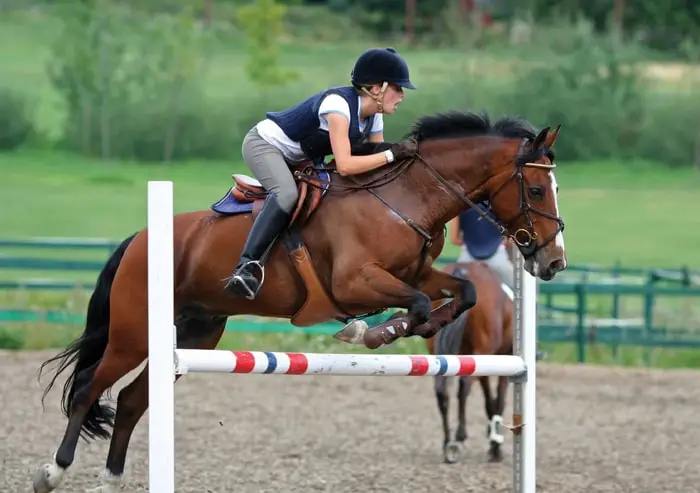
Taking up Eventing
The first and most important thing is getting both horse and rider fit, as eventing is a most demanding sport. By the time a horse is chosen for eventing, he will usually be about four or five years old, reasonably experienced, and have done a little jumping and dressage. Fitness cannot be rushed, either for horse or rider, as strain and injury may result.
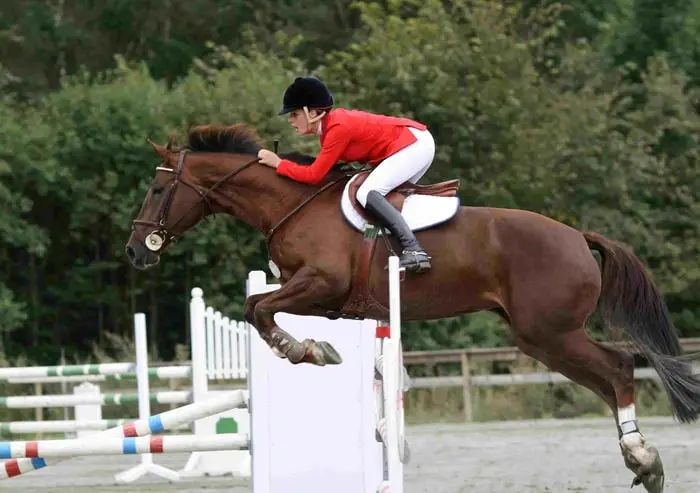
If the horse has been out to grass, getting it fit to begin special training will take at least six weeks, beginning with walking out. After two weeks, he can be trotted for short periods until about five weeks, and he can happily do ten-minute trots on the harness. While he is gaining condition, his back is checked carefully for any rubbing from the unaccustomed saddle, which could cause sores. Now he can start to canter a little, and soon he should be able to take about two hours of varied work without strain.
The Right Equipment for Eventing
Remember that the safety and prevention of accidents must be your number one priority. A crash hat of the right size, correctly adjusted for cross-country riding, is a common-sense precaution, as is a back protector. Your horse should wear a breast girth and surcingle to hold the saddle. Your horse’s legs should be protected, especially if he tends to knock himself when jumping.
Cross-country jumps need different skills from showjumping. The horse will need to be able to shorten or lengthen his strides. Gridwork over poles or cavaletti will help him. Between, gentle hacking over rough ground and up and down hills will help the horse’s balance and accustom him to various states of going. Jumping sessions should not be taken too often-perhaps two or three times a week.
To give him confidence in cross-country, he should not be presented with difficult fences until he is pretty happy over easy ones. If his jumping becomes a little sticky, a lead by an experienced horse may restore fluency, but he will need to go on his own in the competition, so he should not be allowed to get used to being a follower.
Different horses progress at different rates and require different amounts of nourishment. Obstacles should be as varied as possible and include low banks he can jump on and off, jumping brooks, and walking through water to get used to the sight and feel of it. Special care should be taken off his feet with regular shoeing. Experience will tell if he needs to wear protective boots or bandages to stop him from knocking himself.
The horse can be introduced gently to competition with novice dressage or showjumping event, or a hunter trial. This will accustom him to the bustle and atmosphere before he tries a one-day event and give his rider benchmarks for further training.
The First Event
The horse’s first event should be an undemanding one-day one. This is the moment of truth for horse and rider. Early arrival at the course will enable horses and riders to settle before the event. When the rider walks the cross-country course, he will need to plan his attack with his horse’s ability, noting the easiest route, the best place to jump each obstacle, and the state of the going. Often there will be water to jump into cross-country events.
Suppose the horse is familiar with such an obstacle. In that case, it should be carefully regulated so that he will not think of refusing or becoming unsteady through entering the water too fast. A second walk around the course with the plan in mind is a good idea if time is available, but the rider will also have to find time to examine the show jumping course in the same way.
During the day, the rider should make sure his horse is never chilled after excretion. The horse can be given short drinks and small feeds if there is time, at least a couple of hours before galloping. Horses in their natural state graze most of the time, so they require to be fed little and often.
In the cross-country, the aim should be to allow the horse to go at its own pace so long as it is steady. If the horse is excited and starts at great speed, the rider should go with him as he’ll probably be able to exert control more quickly after a fence. Speed can be added later.
Before entering the showjumping arena, warming up needs to be minimal; one or two practice jumps, following another horse’s lead, should be enough to give him confidence. In the arena, the rider should look for the next fence immediately after one is jumped and try to give the horse a good view.
After the event, the horse will need a few weeks’ recovery periods during which he is kept in training. He may need several more one-day events before tackling a three-day one. Training should end about ten days before this with only gentle exercise in the interval-a little dressage work, easy jumping, and cross-country to keep the horse in condition.
Timing is crucial in all three phases of eventing. As the horse progresses to more significant events, his home performance should be of a slightly higher standard than that of the event. The rider will have to learn to time his speed accurately with a stopwatch. To get some idea of the speed required for roads and tracks, a kilometer (⅝ mile ) can be measured out over which the horse should take about four minutes, roughly the time required in the competition. The steeplechase timing is quite fast, and a slightly different technique from the cross-country is needed, something similar to a jockey’s in a hurdle race.
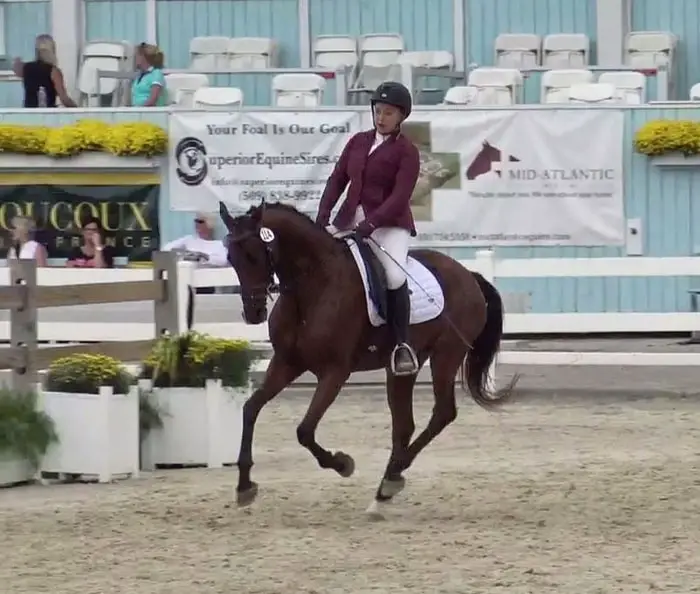
If the rider and saddle weigh under 75 kg, weights will have to be carried; practice is needed in placing the weight cloth in the best position and to get the horse used to the dead weight, which is quite different from the feel of a rider’s.
Horse Eventing: Interval Training of Horse
Interval training is a scientific concept whereby the body is harnessed to condition itself and gradually improve its effectiveness. Typically, any period of intense activity is followed by a necessary rest during which the body restores itself. To put it rather oversimply, in interval training, the rhythm is adjusted so that the time for recovery is just a little less than that required. This stimulates the lungs and heart to work a little harder and increase their capacity, with the effort required never straining the horse. This requires strict monitoring of the horse’s pulse, respiration rate, and temperature.
The trainer notes the horse’s regular pulse, respiration, and temperature at rest and then records them at short intervals after a workout to assess its recovery rate. The program is planned for the horse, taking into account the speed and distance of each period of effort followed by the extent of the recuperative period needed. This could be three periods of cantering followed by walking, the first relaxation period allowing the horse almost fully to recover, and the second being slightly shorter. Because each horse’s capacity is carefully measured throughout training, this method claims never to overstrain the horse.
Concluding Remarks on Horse Eventing
In my article, I have tried to highlight most of the points on horse eventing. Horse eventing is one of the most popular equine sports. The eventing is a regular event of the Olympic Games and FEI. Eventing is a sequential activities dressage, jumping, and cross-country performances. The horse and rider are judged by a team of expert members recommended by FEI.
